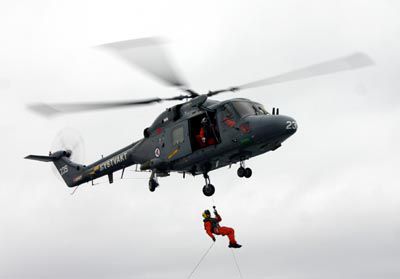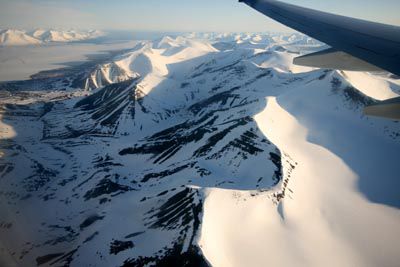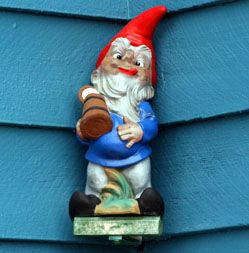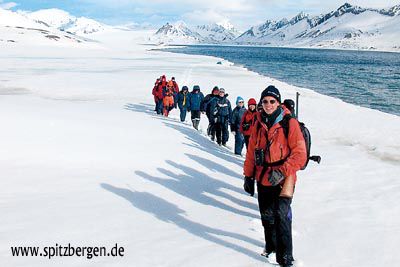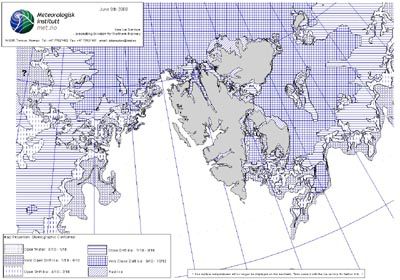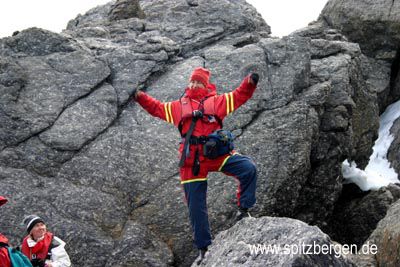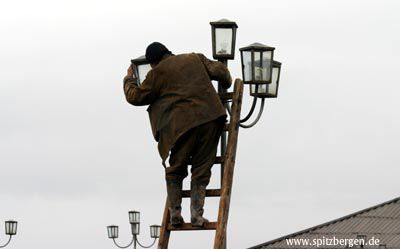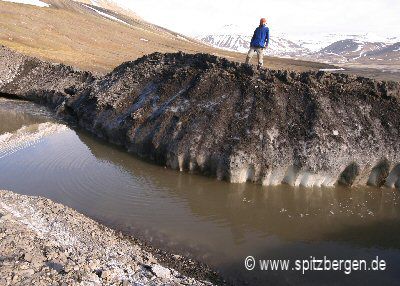
| Guidebook: Spitsbergen-Svalbard |
Yearly Archives: 2008 − News & Stories
Barentsburg: Russian helicopter flights
A law dispute is becoming a political issue: In 2007, the Russian helicopter company Spark Plus operated several helicopter flights from Kapp Heer (Barentsburg) which were not covered by the licence issued by Norwegian authorities, including flights for Russian scientists and for a film project. According to Norwegian officials, the licence covers only flights between Barentsburg and Longyearbyen and beyond this area only flights directly connected to the activities of the Russian mining company Trust Arktikugol (TA). TA has rejected a fine, now the case will be taken up by a court in Norway. Beyond this, the matter is discussed on a political level. According to the Russians, the Norwegian procedure offends the Spitsbergen Treaty. The Norwegians argue that relevant parts of the treaty concern governmental activities, but not those of companies or private persons. In practice, the situation means a monopoly of the Norwegian helicopter company Airlift in Svalbard.
After mine accidents and other technical problems in Barentsburg, mining will only start again in summer 2009. TA has announced to open a “shopping centre” in Barentsburg and to modernise other infrastructure (hotel, telecommunications etc.).
Norwegian coast guard helicopter near Longyearbyen. According to Norwegian law, only Norwegian aircraft may operate in Norwegian air space, exceptions can be permitted.
Source: Svalbardposten
Coal production in Sveagruva profitable
In 2008, about 2 million tons of coal were mined already until early July, more than 300 000 tons more than expected. This together with rising prices on the world market makes for smiling faces in the management of the Norwegian mining company Store Norske Spitsbergen Kullkompani (SNSK), which is making profit – a rare event in the long history of the company. SNSK expects to have paid its debts back by the end of the year. The coal is exported to Europe, where about 60 % are used in energy production and 40 % in the steel industry.
The area of Svea from above.
Source: Svalbardposten
New station in Ny Ålesund
Ny Ålesund is becoming increasingly popular as a base for polar research. The latest newcomer from the far east, after China and Korea, is India, which opened a station in early 2008. Russia has already expressed interest and may be the next nation to follow. Italy, that has already a station in Ny Ålesund, plans to open a “climate tower” to conduct atmospheric research, which is expected to be operational in the summer of 2009.
The Indian research stations in Ny Ålesund.
The German research stations in Ny Ålesund.
Sources: Svalbardposten, Svalbard Science Forum
Prominent visitors to the ice
Spitsbergen has had a larger number of prominent visitors in June and July. In late June, members of the three Scandinavian royal families went on a cruise into the ice on board the Swedish icebreaker Oden, and ministers of a number of countries visited Longyearbyen and Ny Ålesund to meet colleagues and to discuss issues including climate change. The seed vault near Longyearbyen, opened earlier this year, was also high on the wishlist, but the doors usually remain closed, even for high-ranking visitors such as former US-president Jimmy Carter, who wanted to visit the seed vault in early July together with CNN-chef Ted Turner, multimillionaire George Soros and Google founder Larry Page.
According to the local newspaper Svalbardsposten, 76% of the local population consider prominent visitors unimportant.
The Swedish icebreaker Oden with the Scandiavian Crown Princes on board.
Start of summer season 2008
Early and mid June sees the onset of the arctic “high summer”. The summer tourist has begun, and the first ships have already arrived Longyearbyen. An extraordinary amount of snow has fallen during the past winter and spring; locals say that they have never seen so much snow before. In Longyearbyen at sea level, most of the snow has melted by now (10 June), but in many places, there is still a lot of snow at sea level (which on the other hand is not so uncommon at this season).
The ice situation seems to be “better” than in 2006 or 2007 in that sense that there seems to be more sea ice this year. Northern and eastern parts of the archipelago are still mostly surrounded by drift ice, and it will be interesting to follow the development throughout the summer. In recent years, even the northeasternmost parts of Svalbard were accessible as early as late June/early July.
Snow-rich early summer. Early June, Trygghamna.
Ice chart as of 09 Juni 2008 (© Norwegian Meteorological Institute)
Hurray! Start of season soon!
The PCB-project is making progress
In 2007, concentrations of the long-lived environmental toxin PCBs higher than expected have been found in and near the settlements in Spitsbergen. Building materials (paint, concrete) and electrical parts seem to be major sources. The highest values were found in the Russian settlements of Barentsburg and Pyramiden. PCBs from these local sources have already been found in the bottom sediments in the near-by fjords.
Both Russian and Norwegian authorities have apparently already made some progress in removing the dangerous materials. Almost 1000 electrical parts (condensators from lighting installations) have already been removed, and another 2000 is to follow as soon as replacement parts have arrived. These are said to be on the way already. It is also announced that in Pyramiden, which was abandoned in 1998, all relevant parts will soon be completely removed.
All contaminated materials will be shipped to Longyearbyen and from there to the mainland for disposal in Finland as part of the general Norwegian garbage management system.
In the Norwegian settlements and stations (Isfjord Radio, Longyearbyen, Ny Ålesund and Sveagruva), samples were taken from soil, paint and other materials to identify PCB sources. Known sources have already been removed. The aim is to remove all materials containing PCBs within a short time frame.
Lighting in Barentsburg.
Source: Sysselmannen
Permafrost on Mars
The news of the successful landing of the NASA spacecraft “Phoenix” on Mars on 25 May 2008 went around the world. Now, images have been published that show surface structures that resemble frost patterned ground which is common in the Arctic. The stone rings shown in the NASA images are not permafrost structures: their development does not require permafrost, but frequent and strong freezing and thawing. But more importantly, they require water/ice for their formation.
The NASA images.
Stone rings in Spitsbergen (Woodfjord).
Source: NASA
Van Mijenfjord – Sveagruva – Lunckefjellet
Van Mijenfjord is the shipping route to the Norwegian mining settlement of Sveagruva. It is mostly blocked by the long, narrow island of Akseløya, which increases the local fjord ice development significantly. Recently, Norway’s strongest icebreaker, KV “Svalbard”, had to give up breaking the ice to Sveagruva in a distance of 10-12 kilometres to the settlement. The thickness of the ice was near one metre, and one out of four main engines of the vessel was not working. Following behind KV “Svalbard” was a cargo vessel with supplies and equipment for the mine. These had to be unloaded in Longyearbyen and taken to Sveagruva on the ground with bulldozers and by air.
KV “Svalbard” had already broken a lead through most of the length of the fjord. Because of its unique geography (blocked by the above-mentioned island) and in the light of recent climate changes, the fjord is the only one on the west coast of Spitsbergen where regular local ice formation is likely to occur for some time in the future. Fjord ice is an important habitat for arctic wildlife species such as seals who give birth to their offspring on fjor ice and for Polar bears as hunting ground and so on.
Breaking the ice in Van Mijenfjord regularly is thus criticised by environmental organisations. It is one of the reasons why many are sceptical to the plans of the SNSK (Norwegian mining company) to establish a new coal mine at Lunckefjellet north of Sveagruva. Another reason is the large amount of carbon that is stored in the ground in shape of coal, which would be released to the atmosphere in case of mining and subsequent burning.
SNSK argues that their coal is more environmentally friendly than other coal on the world market due to its low methane content. During mining of one ton in Svea, only 0,9 m3 of methane are released to the atmosphere in contrast to 20-40 m3 as the global average, according to SNSK.
Another argument used against the plans for a new mine is the position very close to the boundaries of the Nordenskiöld Land National Park (partly even inside). Regulations for protected areas in Spitsbergen are very strict.
SNSK plans to open the new mine in 2013.
Fjord ice in Van Mijenfjord i April.
Environment: New pollutants / Rising values of atmospheric CO2
It is well known that environmental pollutants such as PCBs that originate from industrialized countries accumulate in the food chain in the Arctic to high levels in species such as Polar bears and Glaucous gulls, both top predators in this environments. Trends in “old” toxins have been observed to be decreasing in recent years, due to bans of relevant substances for example in the EU. It takes a long time for levels to decrease because all relevant substances have in common that they are long-lived, they are still used illegally and some countries have so far failed to issue bans.
The bad news is that new organic pollutants have been found. Production of chemicals for fireproof materials (electronics, furniture, clothing) seems to be the most significant source. Perfluorooctanesulfonic acid (PFOS) seems to be an important new threat; this substance has already reached high levels for example in fat tissue of Polar bears in Svalbard.
Also regional CO2 levels continue to show alarming trends. CO2 is mixing quickly in the atmosphere over the globe, which means that regional trends reflect the global development. The atmospheric observatory on Zeppelinfjellet near Ny Ålesund in Spitsbergen, the average for the first 100 days of 2008 was 391.1 ppm (parts per million), as compared to 388.8 ppm for the same period in 2007. Single measurements beyond 400 ppm are likely to be observed in 2009.
Thawing ice of a pingo in Spitsbergen. Natural part of the complex life cycle of such a permafrost structure. Or result of man-made climate change.
Thawing ice of a pingo in Spitsbergen. Natural part of the complex life cycle of such a permafrost structure. Or result of man-made climate change.
Source: Svalbard Science Forum
Accidents in Barentsburg
In recent weeks, the Russian mining settlement of Barentsburg has suffered from several accidents. Three persons died during a helicopter crash at Kapp Heer, the helicopter base near Barentsburg, The aircraft collided with a building during a landing attempt in bad visibility conditions. On Thursday, 17 April, Barentsburg reported fire in the coal mine. One miner was found dead a while later, while a second one is still missing.
There are still 500 people living in Barentsburg.
